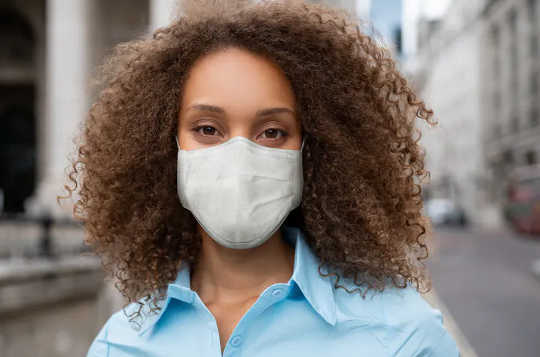
Make sure the bottom of the mask is pulled down over your chin so it covers your nose and mouth. Getty Images / andresr Joy Pieper, Purdue University
Whether or not you agree with a mandate to wear a mask, many of us will do so during our daily business.
I am a professor of nursing at Purdue University, where a colleague and I teach a class detailing the history of health care over the centuries. Among other things, students discover the original reason for a cloth mask, dating back to the late 19th century, is the same as today: to protect others from the germs of those wearing them. Understanding these past practices, say the students, makes them better caregivers.
With that in mind, here are five ways for you to make the most of wearing a mask in public.
 Always wash your hands before putting on your mask. Getty Images / picture alliance
Always wash your hands before putting on your mask. Getty Images / picture alliance
1. Not all masks are created equal
Cloth masks are considered appropriate for general use in public. The Mayo Clinic recommends a mask that is two-layered. This means the cute reversible one your neighbor sewed for you is approved. Not recommended: a mask with a valve. Although the wearer breathes in filtered air, the unfiltered air is pushed out upon exhalation. This negates the protection for others.
2. Wash, wash, wash your hands
Before putting your mask on, wash your hands. This is a basic infection control principle. Anytime you come in contact with your face, do it with clean hands. This includes rubbing your eyes, wiping your lips, or scratching your nose. Likewise, after removing your mask, wash your hands again.
Don’t mess with the mask while it’s in place. This is not the time to take a sip of your latte or snack on your beef jerky. Eat and drink in an environment where you can socially distance from others by at least six feet. If you have to adjust your mask when it’s on, clean your hands afterwards. For convenience, carry a hand sanitizer with you.
3. Does this mask make me look smart?
The mask should fit comfortably snug, always covering your nose and mouth, and secure under the chin. Covering only the mouth is useless. Humans breathe in and out of both nose and mouth. And the purpose of the mask is to block germ transmission through the air, which can occur when one exhales (spreads germs) or inhales (takes in germs) through either nose or mouth.
The World Health Organization offers tips for wearing your mask safely:
{vembed Y=9Tv2BVN_WTk}
4. When you’re done
When it’s time to take it off, clean your hands and grab the ties or ear loops to pull the mask away from your face. Fold the mask in on itself so the outside corners are together. Do not put the mask on your forehead like a headband, or around your neck like a scarf. Place the mask in a receptacle to be laundered. And then wash your hands.
5. Clean it up
Wash the mask with other laundry using your regular detergent. If you’re using a washing machine, use the warmest possible water that’s safe for the type of cloth used to make the mask.
For drying, it’s the same: Use the highest temperature possible for the fabric. Then allow to dry completely before wearing again.
If hand-washing the mask, use a disinfecting bleach. Follow the directions on the product to create the appropriate dilution, then soak the mask five minutes. Rinse with cool water and lay flat to dry or hang in direct sunlight. Be careful not to stretch the fabric; that could damage the mask.
As a former operating room nurse, I know that masks are uncomfortable. Unless it’s Halloween, they’re no fun to wear. But we’re not trying to have fun. We’re trying to keep ourselves, our families and our communities safe. So Google search for the perfect mask to showcase your personality, and wear it correctly with pride!![]()
About the Author
Joy Pieper, Clinical Assistant Professor of Nursing, Purdue University
This article is republished from The Conversation under a Creative Commons license. Read the original article.
Related Books:
The Body Keeps the Score: Brain Mind and Body in the Healing of Trauma
by Bessel van der Kolk
This book explores the connections between trauma and physical and mental health, offering insights and strategies for healing and recovery.
Click for more info or to order
Breath: The New Science of a Lost Art
by James Nestor
This book explores the science and practice of breathing, offering insights and techniques for improving physical and mental health.
Click for more info or to order
The Plant Paradox: The Hidden Dangers in "Healthy" Foods That Cause Disease and Weight Gain
by Steven R. Gundry
This book explores the links between diet, health, and disease, offering insights and strategies for improving overall health and wellness.
Click for more info or to order
The Immunity Code: The New Paradigm for Real Health and Radical Anti-Aging
by Joel Greene
This book offers a new perspective on health and immunity, drawing on principles of epigenetics and offering insights and strategies for optimizing health and aging.
Click for more info or to order
The Complete Guide to Fasting: Heal Your Body Through Intermittent, Alternate-Day, and Extended Fasting
by Dr. Jason Fung and Jimmy Moore
This book explores the science and practice of fasting offering insights and strategies for improving overall health and wellness.

























